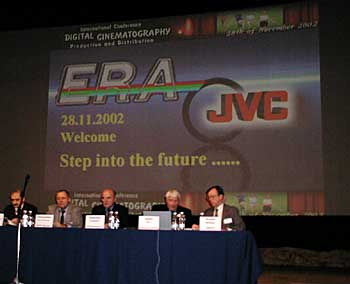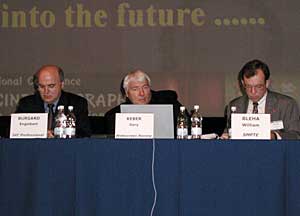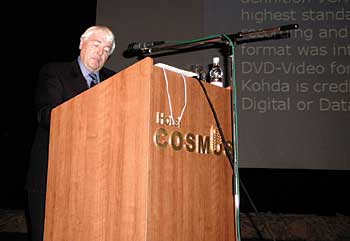|  Mr.
Gary Reber, Editor-In-Chief and Publisher of Widescreen Review
magazine in his presentation on the JVC D-VHS® D-Theater™ platform
will cover the origins of the D-VHS format, the technical elements
that constitute the format, the JVC-developed D-Theater copy
protection encryption scheme, studio support, and the availability
of D-Theater titles. Mr. Reber also will discuss why the platform
should be supported and the value the format has for high value,
high profile content production. Mr.
Gary Reber, Editor-In-Chief and Publisher of Widescreen Review
magazine in his presentation on the JVC D-VHS® D-Theater™ platform
will cover the origins of the D-VHS format, the technical elements
that constitute the format, the JVC-developed D-Theater copy
protection encryption scheme, studio support, and the availability
of D-Theater titles. Mr. Reber also will discuss why the platform
should be supported and the value the format has for high value,
high profile content production.
Text Of Presentation
The first working device for producing electrical signals for television transmission
was a mechanical scanning system built by Paul Nipko in 1884. Later Valdimer
Zworykin immigrated to the United States from Russia to develop an all-electronic
television system. It was only after a technical paper given by Zworykin in 1929
that another Russian immigrant and then Vice President of the Radio Corporation
of America (RCA), David Sarnoff, was inspired enough to create a business. Sarnoff
provided Zworykin with the laboratory resources to realize the dream and then
in 1939 announced to the world at the New York World’s Fair that the beginning
of a new era—an era where moving images and sound would be in every home—was
at hand.
Sarnoff controlled both the manufacturing of television sets through RCA and
the transmission signals via the National Broadcast Corporation (NBC). Sarnoff
clearly understood that only with a combination in the marketplace of consumer
TV sets and TV signals could the industry be born.
In 1996, fifty-seven years later, the Victor Company of Japan introduced a high-definition
VCR platform that set the highest standard for consumer use recording and playback.
The D-VHS format was introduced a year before the DVD-Video format is launched.
Kazuno Kohda is credited with the invention of Digital or Data-VHS.
The D-VHS format sets the highest standard thus far for HD picture quality, and
as well, sound quality in a home video format.
As a home theatre enthusiast magazine, I founded Widescreen Review with the intent
to educate and serve as a technical resource that explored ”the best that
it can be” in a home theatre movie experience. Widescreen Review is a magazine
with no vested interest in any technology, nor egotistical interest in a particular
product technology. Widescreen Review has been criticized by some people and
others in the media who think that we’re posing D-VHS as a competitor to
HD-DVD, or even the existing DVD format. This is absolutely not true. As an enthusiast
publication, we are only interested in “the best that it can be,” regardless
of technology or manufacturer, or price, and like everyone else we cannot always
afford “the best” for the magazine’s reference systems, but
we surely can appreciate the accomplishment.
Experience has taught me that by supporting “the best that it can be” in
the magazine, the bar for excellence raises across the board, and often results
in better performance in products that are far less expensive down the road.
We brought this platform to the attention of our enthusiast readers with our
recent filled-to-capacity weekend D-Theater Movie Festivals. We premiered to
enthusiast and leading industry figures the extraordinary dimensionality and
resolution that the D-VHS D-Theater platform delivers as an “HD-plus” home
theatre experience, far exceeding the performance capabilities of the very best
DVDs, and even ATSC-standard (American Television Standards Committee) HDTV over-the-air
and satellite-delivered broadcasts.
D-VHS was developed in order to meet the recording requirements of digital broadcasts
while ensuring that the existing VHS video images that have accumulated thus
far will remain accessible and will not become obsolete.
In the 21st century, not only will TV broadcasts and cinema exhibition go digital,
but a wide variety of information will be transmitted as digital signals (bit
stream data), and a household appliance that can record and store information
will become necessary.
Among the various types of storage media, D-VHS tape media has the advantage
of removable high-storage capacity (50 GB). Even next-generation optical discs
can only store 15 to 27 GB (gigabytes) of data on a single side, which is only
about half that of D-VHS.
As previously stated, the D-VHS format was launched by JVC, the developer of
VHS, in 1996. The format features full HD record and playback capability, and
can decode D-VHS video recorded in the 18 ATSC digital video formats. D-VHS shares
the same form factor tapes as standard VHS. The format is backward record and
playback compatible with Super-VHS and VHS.
 D-VHS
delivers an incredible 28.2 megabits per second (Mbps) bit rate.
This is a substantially higher data rate than the 19.3 Mbps ATSC
HDTV standard bit rate for over-the-air broadcast HDTV in the
United States, and far exceeds the 4.5 Mbps DVD-Video average
data transfer rate for a two-hour movie. As with the ATSC and
DVD-Video systems, the format uses MPEG-2 compression. Because
of D-VHS’s 28.2 data rate HD ASTC broadcasts can be recorded
with no additional compression, thus capturing 100 percent of
the broadcast signal quality. D-VHS
delivers an incredible 28.2 megabits per second (Mbps) bit rate.
This is a substantially higher data rate than the 19.3 Mbps ATSC
HDTV standard bit rate for over-the-air broadcast HDTV in the
United States, and far exceeds the 4.5 Mbps DVD-Video average
data transfer rate for a two-hour movie. As with the ATSC and
DVD-Video systems, the format uses MPEG-2 compression. Because
of D-VHS’s 28.2 data rate HD ASTC broadcasts can be recorded
with no additional compression, thus capturing 100 percent of
the broadcast signal quality.
D-VHS’s information density is 1920 x 1080 versus DVD-Video standard-definition
(SD) 720 x 480. The format supports up to 50 GB of storage capacity. Such capacity
supports up to four (4) hours of HD recording at 28.2 Mbps and 16 hours of SD
(DVD-Video quality) recording at 6 Mbps, or eight (8) hours at 14.1 Mbps.
The D-VHS format adopts IEEE 1394 as the digital input/output interface (also
referred to as FireWire® or iLink®) incorporating DTCP or Digital Transmission
Content Protection (also known as 5-C) copy protection technology.
JVC’s first generation D-VHS D-Theater VCR, the HM-DH30000U, will output
MPEG digital video from its IEEE 1394 interface (four-pin terminal), but only
when that video is not copy-protected. Digital video from DVDs that are not copy
protected can be recorded via the DVD analog video and audio outputs using the
HM-DH30000U on-board A/D converter and MPEG encoder, but most DVDs are copy-protected.
The JVC HM-DH30000U features, in addition to IEEE 1394, an analog HDTV video
output compatible with the YPbPr input included on most high-definition displays
and will output YPbPr analog component video signals in the 1080i (interlaced),
720p (progressive), 480p, or 480i formats. The format and the JVC VCR are also
capable of outputting 1080p. The platform’s supporting studios and JVC
are working on the 1080p-mastering interface. It is the intent of the studios
and JVC to eventually release D-Theater-encrypted movies in 1080p.
The D-VHS D-Theater platform is Dolby® Digital 5.1-capable in playback of
prerecorded D-VHS and D-Theater content up to the full 640 kilobits per second
(kbps) data rate. When recording through the IEEE 1394 interface the data rate
of the source Dolby Digital bit stream will be recorded.
With respect to DTS®, there is a caveat—JVC is completing work on their
DTS Digital Surround™ encoder so that future D-Theater titles can be encoded
in the full DTS bit stream. The supporting studios intend to release D-Theater
titles with a DTS bit stream.
In order to secure the support of Hollywood studios to release their movies on
the format, JVC developed D-Theater-encrypted copy protection. This extremely
robust encryption algorithm was introduced in 2001. Following extensive testing
by the studios, the home entertainment divisions of four studios—Artisan
Entertainment, DreamWorks Home Entertainment, 20th Century Fox Home Entertainment,
and Universal Studios Home Video—joined with JVC to support the new D-VHS
D-Theater software platform for high-definition copyrighted prerecorded content.
The studios are satisfied that the D-Theater encryption scheme provides a secure
level of protection to prevent the unauthorized duplication of their movies and
other high-value prerecorded content. The support of these major content providers
marks the next phase in the acceptance of high-definition as the new standard
for home entertainment and television.
As of November 28 there are 40 prerecorded titles now available—25 studio
titles D-Theater encrypted and 15 HDNet D-VHS titles without D-Theater encryption.
HDNet is a HD channel carried by the DirecTV satellite network.
All of the D-Theater HD tapes are mastered in the 28.2 Mbps mode, a substantially
higher data rate than the ATSC standard 19.3 Mbps for HDTV, so D-Theater movies
can deliver even higher quality images than HDTV broadcasts. In fact, some terrestrial
and satellite broadcasts do not even use the full ASTC bit rate.
The first day-and-date D-Theater title to be released simultaneously with the
DVD-Video and VHS release was 20th Century Fox Home Entertainment’s Ice
Age. The release date was November 26. Not only is this the first day-and-date
D-Theater title, but Fox’s $180 million smash hit also features the first “Special
Edition” on this new HD format, boasting an all-new, exclusively produced
five-minute CGI animated short, Scrat’s Missing Adventure.
When
the provision for D-Theater was introduced in 2001, JVC made D-Theater
a part of D-VHS licensing. Still, there is at present only one D-VHS
VCR marketed in North America with the D-Theater feature—JVC’s
HM-DH30000U. Mitsubishi, which markets another D-VHS VCR in North
America, chose not to license D-Theater, even though without the
D-Theater feature prerecorded movies released by studios will not
play back. The D-Theater feature is licensed for use only in North
America at the present time.
The D-Theater feature adds chapter search, audio selection, running audio commentary,
alternate foreign languages, and closed-captioning to the standard D-VHS feature
set. While these features are impressive for a VCR, other interactive features
found on DVD are not possible on the D-VHS D-Theater platform.
Why support?
The compelling reason to support the D-VHS D-Theater platform is the attraction
of prerecorded HD movies. The other compelling reasons to support the platform
are the capability to record HD, archival of content long-term, and compatibility
with legacy VHS software.
Prerecorded movies are available now! I made the decision to support Widescreen
Review’s readership, which I knew would embrace this platform, with a shopping
service so they could purchase D-VHS and D-Theater titles directly from www.WidescreenReview.com
and our subsidiary Web site - www.DVHSMovieGuide.com.
 Looking
back over the past ten years of Widescreen Review’s existence,
I felt that the D-VHS D-Theater platform was a significant event
in the history of imaging science. I have been a proponent of
true high-definition video since the inception of the technology,
and extensively covered the H(DTV) debate amongst the technologists,
broadcasters, Federal Communication Commission (FCC), and the
Consumer Electronics Association (CEA). Thus, I have been deeply
involved in the issues surrounding the transition from analog
to digital broadcast since founding the magazine. While the issues
with respect to HDTV in the United States are still unresolved
and there is much to write about, I think it is important to
appreciate that the D-VHS format sets the highest standard thus
far for HD picture quality and is playing an integral role in
the transition to H(DTV). Looking
back over the past ten years of Widescreen Review’s existence,
I felt that the D-VHS D-Theater platform was a significant event
in the history of imaging science. I have been a proponent of
true high-definition video since the inception of the technology,
and extensively covered the H(DTV) debate amongst the technologists,
broadcasters, Federal Communication Commission (FCC), and the
Consumer Electronics Association (CEA). Thus, I have been deeply
involved in the issues surrounding the transition from analog
to digital broadcast since founding the magazine. While the issues
with respect to HDTV in the United States are still unresolved
and there is much to write about, I think it is important to
appreciate that the D-VHS format sets the highest standard thus
far for HD picture quality and is playing an integral role in
the transition to H(DTV).
An ultimate optical-based HD format will be required to equal or surpass such
performance, in order for it to be embraced by enthusiasts. There are currently
three main contenders for the HD throne, and each has its own combination of
formats and codecs. All three variations of HD-DVD will require new players to
read the discs. The DVD Forum, the standard-setting body for the DVD format,
will use the 0.6-mm bonded disk proposed by NEC Corporation and Toshiba Corporation
as the basis of its next-generation DVD standard utilizing a blue laser. This
next-generation HD-DVD represents a minimal extension of the current DVD format
with smaller pits and tracks, but no change to the data layer depth, although
a blue laser is needed to read the disc. Video can be encoded with MPEG-2 or
a new codec still to be chosen. While NEC and Toshiba jointly proposed the Advanced
Optical Disk System to the DVD Forum in August, the Blu-ray Disk proponents,
supporting a competing blue-laser technology, have decided to launch their format
without the sanction of the DVD Forum, even though the nine companies supporting
the format are also members of the DVD Forum. The third contender is the AOL
Time Warner proposal for an HD-DVD-9 disc, an adaptation of the existing dual-layer
DVD-9 format, requiring no changes to the physical disc, only a new codec for
the video. Thus, as previously forecast in Widescreen Review past issues, an
impending format battle is imminent. Even so, already, the D-VHS D-Theater platform
is proving to satisfy current and future HD adopters, as is evidenced by the
increasingly supportive home theatre Internet forums - www.hometheaterforum.com and www.avsforum.com -
and the sales of JVC’s HM-DH30000U VCR and prerecorded D-Theater titles.
As a production tool the D-VHS format is a cost-effective medium for viewing
HD dailies and other work. Blank tapes cost either $15 or $25, depending on storage
capacity. Studios like the medium because of its full content security via D-Theater
encryption. The presentation quality is equal to that of d-cinema screenings
of motion pictures. Picture performance rivals the D-5 digital video studio master,
even at 28.2 Mbps versus 375 Mbps. We performed extensive A/B comparisons at
the Widescreen Review facilities using D-5 clones and D-Theater versions of several
Universal Studios titles in our Reference Holosonic™ Home Theatre Laboratory
using our state-of-the-art Runco and Sony 9-inch CRT projection systems and Stewart
Filmscreen. The two sources were virtually indistinguishable. We concluded: “D-VHS
is D-5, slightly softer!”
It’s more than HDTV.
The D-VHS D-Theater platform isn’t only about HDTV. The platform provides
standard-definition digital recording quality that is far superior to anything
available from an analog VCR. For those who keep a library of programming from
satellite or terrestrial broadcasts, switching to digital tape will greatly improve
picture quality.
There simply are no other current alternatives for prerecorded HDTV programming,
and I believe competing self-interests, economic issues, and copy protection
concerns still put a high-definition optical disc introduction two to four years
away.
Even though D-VHS D-Theater is a step back in operating convenience, it is a
giant leap forward in accessible video quality and the ability to choose what
and when we watch HDTV.
I certainly hope that HD-DVD meets or exceeds the specifications of D-VHS.
Still, I support D-VHS, because right now it is technically the best video format
available to the consumer in terms of picture (and sound) quality, and rivals
the picture quality of d-cinema.
I think D-VHS can be an integral part of the overall transition to H(DTV), since
in the United States we’re at a point in time now where some real tangible
software is needed to demonstrate to a wider audience the capability of HD, as
well as to serve the early and current adopters who have already invested in
HD-capable displays and are eagerly waiting for true HD-quality source material.
Having some really good HD programming from motion pictures is key in this respect.
|